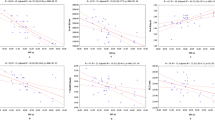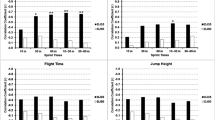Abstract
In this study, the performance and selected physiological responses to team-sport specific repeated-sprint and jump sequence were investigated. On four occasions, 13 team-sport players (22 ± 3 year) performed alternatively six repeated maximal straight-line or shuttle-sprints interspersed with a jump ([RS+j, 6 × 25 m] or [RSS+j, 6 × (2 × 12.5 m)]) or not ([RS, 6 × 25 m] or [RSS, 6 × (2 × 12.5 m)]) within each recovery period. Mean running time, rate of perceived exertion (RPE), pulmonary oxygen uptake (\( \dot{V} \)O2), blood lactate ([La]b), and vastus lateralis deoxygenation ([HHb]) were obtained for each condition. Mean sprint times were greater for RS+j versus RS (4.14 ± 0.17 vs. 4.09 ± 0.16 s, with the qualitative analysis revealing a 82% chance of RS+j times to be greater than RS) and for RSS+j versus RSS (5.43 ± 0.18 vs. 5.29 ± 0.17 s; 99% chance of RSS+j to be >RSS). The correlation between sprint and jump abilities were large-to-very-large, but below 0.71 for RSSs. Jumps increased RPE (Cohen’s d ± 90% CL: +0.7 ± 0.5; 95% chance for RS+j > RS and +0.7 ± 0.5; 96% for RSS+j > RSS), \( \dot{V} \)O2 (+0.4 ± 0.5; 80% for RS+j > RS and +0.5 ± 0.5; 86% for RSS+j > RSS), [La]b (+0.5 ± 0.5; 59% for RS+j > RS and +0.2 ± 0.5; unclear for RSS+j > RSS), and [HHb] (+0.5 ± 0.5; 86% for RS+j > RS and +0.5 ± 0.5; 85% for RSS+j > RSS). To conclude, repeated- sprint and jump abilities could be considered as specific qualities. The addition of a jump within the recovery periods during repeated-sprint running sequences impairs sprinting performance and might be an effective training practice for eliciting both greater systemic and vastus lateralis physiological loads.


Similar content being viewed by others
References
Batterham AM, Hopkins WG (2006) Making meaningful inferences about magnitudes. Int J Sports Physiol Perform 1:50–57
Beckett JR, Schneiker KT, Wallman KE, Dawson BT, Guelfi KJ (2009) Effects of static stretching on repeated sprint and change of direction performance. Med Sci Sports Exerc 41:444–450
Ben Abdelkrim N, El Fazaa S, El Ati J (2007) Time-motion analysis and physiological data of elite under-19-year-old basketball players during competition. Br J Sports Med 41:69–75 (discussion 75)
Billaut F, Basset FA, Falgairette G (2005) Muscle coordination changes during intermittent cycling sprints. Neurosci Lett 380:265–269
Bravo DF, Impellizzeri FM, Rampinini E, Castagna C, Bishop D, Wisloff U (2008) Sprint vs. interval training in football. Int J Sports Med 29:668–674
Buchheit M (2008) The 30–15 intermittent fitness test: accuracy for individualizing interval training of young intermittent sport players. J Strength Cond Res 22:365–374
Buchheit M, Laursen PB, Ahmaidi S (2007) Parasympathetic reactivation after repeated sprint exercise. Am J Physiol Heart Circ Physiol 293:H133–H141
Buchheit M, Al Haddad H, Leprêtre PM, Millet G, Newton M, Ahmaidi S (2009a) Cardiorespiratory and cardiac autonomic responses to 30–15 intermittent fitness test. J Strength Cond Res 23:93–100
Buchheit M, Cormie P, Abbiss CR, Ahmaidi S, Nosaka KK, Laursen PB (2009b) Muscle deoxygenation during repeated sprint running: effect of active vs. passive recovery. Int J Sports Med 30:418–425
Buchheit M, Laursen PB, Ahmaidi S (2009c) Effect of prior exercise on pulmonary O2 uptake and estimated muscle capillary blood flow kinetics during moderate-intensity field running in men. J Appl Physiol 107:460–470
Buchheit M, Bishop D, Haydar B, Nakamura F, Ahmaidi S (2010a) Physiological responses to shuttle repeated-sprint running. Int J Sport Med 31:402–409
Buchheit M, Mendez-Villanueva A, Delhomel G, Brughelli M, Ahmaidi S (2010b) Improving repeated sprint ability in young elite soccer players: repeated sprints vs. explosive strength training. J Strength Cond Res, Mar 10 [Epub ahead of print]
Buchheit M, Mendez-Villanueva A, Quod MJ, Quesnel T, Ahmaidi S (2010c) Improving acceleration and repeated sprint ability in well-trained adolescent handball players: speed vs. sprint interval training. Int J Sports Physiol Perform 5:152–164
Buchheit M, Spencer M, Ahmaidi S (2010d) Reliability, usefulness and validity of a repeated sprint and jump ability test. Int J Sports Physiol Perform 5:3–17
Castagna C, Abt G, Manzi V, Annino G, Padua E, D’Ottavio S (2008) Effect of recovery mode on repeated sprint ability in young basketball players. J Strength Cond Res 22:923–929
Christmass MA, Dawson B, Arthur PG (1999) Effect of work and recovery duration on skeletal muscle oxygenation and fuel use during sustained intermittent exercise. Eur J Appl Physiol Occup Physiol 80:436–447
Clarke D, Clarke H (1970) Research processes in physical education, recreation and health. Engelwood Cliffs, NJ, Prentice-Hall
Cohen J (1988) Statistical power analysis for the behavioral sciences. Hillsdale, Lawrence Erlbaum
De Blasi RA, Cope M, Elwell C, Safoue F, Ferrari M (1993) Noninvasive measurement of human forearm oxygen consumption by near infrared spectroscopy. Eur J Appl Physiol Occup Physiol 67:20–25
DeLorey DS, Kowalchuk JM, Paterson DH (2005) Adaptation of pulmonary O2 uptake kinetics and muscle deoxygenation at the onset of heavy-intensity exercise in young and older adults. J Appl Physiol 98:1697–1704
Edge J, Bishop D, Goodman C (2006) Effects of chronic NaHCO3 ingestion during interval training on changes to muscle buffer capacity, metabolism, and short-term endurance performance. J Appl Physiol 101:918–925
Esaki K, Hamaoka T, Radegran G, Boushel R, Hansen J, Katsumura T, Haga S, Mizuno M (2005) Association between regional quadriceps oxygenation and blood oxygen saturation during normoxic one-legged dynamic knee extension. Eur J Appl Physiol 95:361–370
Glaister M (2008) Multiple-sprint work: methodological, physiological, and experimental issues. Int J Sports Physiol Perform 3:107–112
Hopkins WG, Marshall SW, Batterham AM, Hanin J (2009) Progressive statistics for studies in sports medicine and exercise science. Med Sci Sports Exerc 41:3–13
Impellizzeri FM, Rampinini E, Castagna C, Bishop D, Ferrari Bravo D, Tibaudi A, Wisloff U (2008) Validity of a repeated-sprint test for football. Int J Sports Med 29:899–905
Jacobs R, Bobbert MF, van Ingen Schenau GJ (1993) Function of mono- and biarticular muscles in running. Med Sci Sports Exerc 25:1163–1173
Kale M, Asci A, Bayrak C, Acikada C (2009) Relationships among jumping performances and sprint parameters during maximum speed phase in sprinters. J Strength Cond Res 23:2272–2279
Luig P, Manchado Lopez C, Pers J, Perse M, Kristan M, Schander I, Zimmermann M, Henke T, Platen P (2008) Motion characteristics according to playing position in international men’s team handball. 13th annual congress of the european college of sport science, Estoril, Portugal
McLaughlin JE, King GA, Howley ET, Bassett DR Jr, Ainsworth BE (2001) Validation of the COSMED K4 b2 portable metabolic system. Int J Sports Med 22:280–284
Oliver JL (2009) Is a fatigue index a worthwhile measure of repeated sprint ability? J Sci Med Sport 12:20–23
Perrey S, Racinais S, Saimouaa K, Girard O (2010) Neural and muscular adjustments following repeated running sprints. Eur J Appl Physiol 109:1027–1036
Prieur F, Berthoin S, Marles A, Blondel N, Mucci P (2010) Heterogeneity of muscle deoxygenation kinetics during two bouts of repeated heavy exercises. Eur J Appl Physiol 109:1047–1057
Pyne DB, Boston T, Martin DT, Logan A (2000) Evaluation of the lactate pro blood lactate analyser. Eur J Appl Physiol 82:112–116
Rusko H, Nummela A, Mero A (1993) A new method for the evaluation of anaerobic running power in athletes. Eur J Appl Physiol 66:97–101
Sheppard JM, Gabbett T, Taylor KL, Dorman J, Lebedew AJ, Borgeaud R (2007) Development of a repeated-effort test for elite men’s volleyball. Int J Sports Physiol Perform 2:292–304
Smith KJ, Billaut F (2010) Influence of cerebral and muscle oxygenation on repeated-sprint ability. Eur J Appl Physiol 109:989–999
Spencer M, Bishop D, Dawson B, Goodman C (2005) Physiological and metabolic responses of repeated-sprint activities: specific to field-based team sports. Sports Med 35:1025–1044
Spencer M, Bishop D, Dawson B, Goodman C, Duffield R (2006a) Metabolism and performance in repeated cycle sprints: active versus passive recovery. Med Sci Sports Exerc 38:1492–1499
Spencer M, Fitzsimons M, Dawson B, Bishop D, Goodman C (2006b) Reliability of a repeated-sprint test for field-hockey. J Sci Med Sport 9:181–184
Stone NM, Kilding AE (2009) Aerobic conditioning for team sport athletes. Sports Med 39:615–642
Vescovi JD, McGuigan MR (2008) Relationships between sprinting, agility, and jump ability in female athletes. J Sports Sci 26:97–107
Wisloff U, Castagna C, Helgerud J, Jones R, Hoff J (2004) Strong correlation of maximal squat strength with sprint performance and vertical jump height in elite soccer players. Br J Sports Med 38:285–288
Acknowledgments
The authors thank Irmant Cadjiov for his great assistance with the preparation of the manuscript and Bachar Haydar for his help data collection.
Author information
Authors and Affiliations
Corresponding author
Additional information
Communicated by Jean-René Lacour.
Rights and permissions
About this article
Cite this article
Buchheit, M. Performance and physiological responses to repeated-sprint and jump sequences. Eur J Appl Physiol 110, 1007–1018 (2010). https://doi.org/10.1007/s00421-010-1587-3
Accepted:
Published:
Issue Date:
DOI: https://doi.org/10.1007/s00421-010-1587-3




